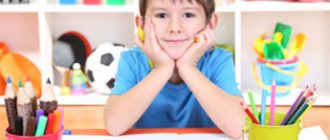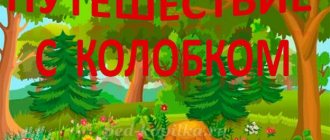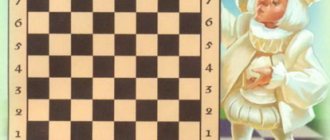Summary of a lesson on the basics of ecology in the second junior group “Journey to a fairy forest”
Ksenia Yakubovich
Summary of a lesson on the basics of ecology in the second junior group “Journey to a fairy forest”
2 junior correctional group
Date of: ___
Educational field: Cognition
Section: Fundamentals of Ecology
Theme: Fairy forest
Target:
Correctional and educational: to arouse interest in the world around us, to expand children’s ideas and knowledge about plants and their significance in our lives.
Correctional and developmental: develop speech, activate attention and memory.
Correctional and educational: to cultivate a love of nature.
Equipment: Leaves, subject cards, two envelopes,
Stages of activity Actions of the teacher Actions of children
Motivational
occupation today .
First let's wake up and wake up our fingers.
A squirrel sits on a cart and sells nuts:
Little fox-sister, sparrow, titmouse,
Thick-fifted bear, mustachioed bunny
Guys, a squirrel brought us a letter from the forest.
Shall we read it?
It says here that they are waiting for us to visit a fabulous autumn forest ! Shall we go for a visit? They are listening.
Finger gymnastics.
Show interest
Yes
Organizational
search engine Who can tell me how to behave in the forest? You can't shout or make noise in the forest. We can scare birds and animals with our scream.
Do not break branches of trees and bushes. Plants are living beings.
You cannot throw or leave garbage in the forest. The forest is the home of animals and birds. If we all know the rules of behavior in the forest, then we can go into the forest.
We line up in our magic train that will take us. (Line up in a train and walk like a snake through the group )
So we arrived in the forest. Pay attention, guys, what a beautiful forest we found ourselves in. Children, what grows in the forest?
That's right trees! And what else? There are bushes and different types of grass growing in the forest. What trees do you know? Why are the trees naked? Where did the leaves go? Trees shed their leaves to help them survive the winter. What is this phenomenon called? That's right, in the fall the leaves fall - this phenomenon is called leaf fall. Do you know which leaves are from which tree? (Show and tell about the leaves .)
Guys, look how many leaves fell from the trees and how different they all are.
Come on, you and I will collect the leaves and take them to the tree from which they fell. Guys, tell me which tree you collected the leaves from. Name it. Well done. It's time for us to return to our group . Let's board our magical locomotive. (Line up in a train and walk like a snake through
the group ) So we are back in kindergarten! Children's answers to questions posed by the teacher
Listening
They form a train behind the teacher.
Children's answers to questions posed by the teacher
Children name the names of the trees.
They form a train behind the teacher.
Reflexively
corrective Children, did you enjoy the walk in the magical forest? Look guys, we got another letter! Let's see what's there? Because we behaved well in the forest, the forest dwellers give us leaves like these!
Children's answers to questions posed by the teacher
Know: trees and their significance in our lives.
Have: interest in the world around you, love of nature.
Be able to: answer the teacher’s questions
MAGAZINE Preschooler.RF
PLAN - OUTLINE GCD on environmental education in the second junior group of kindergarten Target:— Formation in children of a responsible and friendly attitude towards nature;
- Empathy for a living organism.
Tasks:
— Foster a humane, caring attitude towards the world around us as a whole;
— Develop cognitive interest in the natural world;
— Develop a sense of empathy for natural objects;
— Instill in children an environmental culture of behavior;
— To develop initial skills in environmentally literate behavior that is safe for nature and for the child himself;
— To form a system of basic environmental scientific knowledge that is understandable to a 3-4 year old child.
Type of lesson: Ecological-cognitive direct educational activity.
Methods: Cognition, speech development, artistic creativity, musical accompaniment, fiction.
Equipment: Tape recorder; recordings of starling singing and background music, Pictures of starlings; a real feeder outside the window or in a picture; material and equipment for drawing, willow branches.
Predicted result:
— Emotional perception of the surrounding natural world;
— Mastering ecological norms of behavior in nature.
Progress of the lesson
Educator: Guys, guess what time of year this riddle is about:
The time has come for winter to replace, to awaken Nature from sleep. The snow has melted, a wedge of birds is floating across the sky, Spring has brought us warmth.
What time of year is it now? (shows a picture).
Children: Spring
Educator:
What does snow do in the spring?... What do streams do in the spring?... What do birds do in the spring?...
Educator: After winter comes spring and calls the birds home. Our feathered friends will return. Let's listen to music. (The music “Voices of Birds” sounds.) The first to arrive are rooks, swallows, and starlings. (Shows birds.) Rooks and swallows are making nests. (Shows.) And the starling will have nowhere to live.
He flies every year to where the house is waiting for him, a strong wooden house with a small round window. (Skvorets.)
Starling
Educator: The house for starlings is called a birdhouse. (The teacher reads a fairy tale)
Starling.
Once upon a time there was a Starling. In the fall he flew to the thirtieth kingdom - the state. In the spring he returned home to his favorite tree, hatched the chicks, and fed them caterpillars and bugs. One day the Starling returned after the winter and did not find his house. People cut down the tree. The Starling got upset, stopped singing his songs and flew away to distant lands. And many caterpillars and bugs (pests) appeared around. They ate all the plants. The adults realized their mistake and called Starling back, but he did not return.
Then the children decided to help. They built houses and hung them on the tallest trees. Starling liked the new house; he returned not alone, but with his friends. They began to sing songs and raise chicks. The children were very happy.
Physical school
Oh, starlings were flying. Everyone was flying, singing songs, flapping their wings. (Waving your arms)
They sat down on the ground in a flock and ate the worms. (Turn towards the feeder)
Peck, peck, peck, peck, (Squat down)
Peck, peck, peck, peck, how I love worms. (Tap the floor with your index fingers)
Let's clean the feathers so that they are cleaner. (Rub your forearms with your hands, as if hugging yourself)
Like this, like this, like this, like this, so that they are cleaner.
We jump on the branches so that the children become stronger. (Turn towards the trees outside the windows)
There's a knock on the door, a starling flies in. - starling singing
Starling: Hello, guys, I flew to you from a distant land and can’t find a house for myself. Can you help me find him?
(The children agree to help the Starling, draw birdhouses. The children are offered wax crayons, a white sheet of paper; on a sheet of paper they draw a birdhouse. Then they take a willow twig, glue it onto a sheet of paper, above the birdhouse.) - the music “Cuckoo and the Starling” plays in the background
Starling: Thank you very much, guys, for helping me. I will invite my friends to these houses. It's time to fly after them.
Educator: Wait, Starling, don’t fly away. The guys have prepared a poem for you.
(Children recite a previously learned poem)
Barto A.L. - "April"
Willow, willow, willow, The willow has bloomed. This means, it’s true, That spring has come. It means, it’s true, That winter is over. The very, very first starling whistled. He whistled in the birdhouse: Well, now I belong here.
Starling: Thank you very much, guys, for the houses, for the poem. I am very happy. It's time for me to fly and move into the birdhouse. Goodbye. - Starling singing.
All: Goodbye.
Result: And while we are walking, we will not forget to feed the birds. What birds will we feed?... Who will we treat with lard?... And who will we give seeds?..., grains?...
| Next > |
Junior group. Early childhood, nursery. Children 1-4 years old
Poster "Take care of nature." Collaborative activities between teachers and young children
Poster "Take care of nature "
. Joint activities of a teacher with young children. From an early age, children need to be instilled with the concept that the planet is our common home, we need to take care of it, protect it with all our might: we need to protect the air we breathe, we need to save the water that...
Summary of the lesson on ecology “Take care of nature” (second junior group) In MBDOU 288, group 5, environmental lessons were held as part of the All-Russian campaign “ Ecolyats - Young Nature Defenders ”. While working with children, we touched on the topic “Take care of nature ,” formed a responsible attitude towards nature , increased the level of environmental ...


